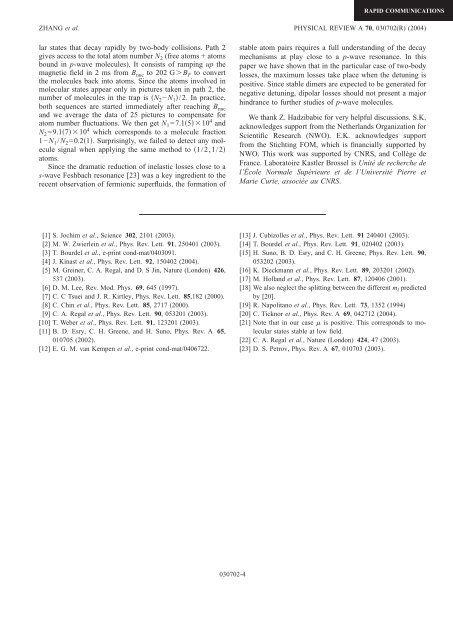Martin Teichmann Atomes de lithium-6 ultra froids dans la ... - TEL
Martin Teichmann Atomes de lithium-6 ultra froids dans la ... - TEL
Martin Teichmann Atomes de lithium-6 ultra froids dans la ... - TEL
Create successful ePaper yourself
Turn your PDF publications into a flip-book with our unique Google optimized e-Paper software.
ZHANG et al. PHYSICAL REVIEW A 70, 030702(R) (2004)<br />
<strong>la</strong>r states that <strong>de</strong>cay rapidly by two-body collisions. Path 2<br />
gives access to the total atom number N 2 (free atoms + atoms<br />
bound in p-wave molecules). It consists of ramping up the<br />
magnetic field in 2 ms from B nuc to 202 G�B F to convert<br />
the molecules back into atoms. Since the atoms involved in<br />
molecu<strong>la</strong>r states appear only in pictures taken in path 2, the<br />
number of molecules in the trap is �N 2−N 1�/2. In practice,<br />
both sequences are started immediately after reaching B nuc<br />
and we average the data of 25 pictures to compensate for<br />
atom number fluctuations. We then get N 1=7.1�5��10 4 and<br />
N 2=9.1�7��10 4 which corresponds to a molecule fraction<br />
1−N 1/N 2=0.2�1�. Surprisingly, we failed to <strong>de</strong>tect any molecule<br />
signal when applying the same method to �1/2,1/2�<br />
atoms.<br />
Since the dramatic reduction of ine<strong>la</strong>stic losses close to a<br />
s-wave Feshbach resonance [23] was a key ingredient to the<br />
recent observation of fermionic superfluids, the formation of<br />
[1] S. Jochim et al., Science 302, 2101 (2003).<br />
[2] M. W. Zwierlein et al., Phys. Rev. Lett. 91, 250401 (2003).<br />
[3] T. Bour<strong>de</strong>l et al., e-print cond-mat/0403091.<br />
[4] J. Kinast et al., Phys. Rev. Lett. 92, 150402 (2004).<br />
[5] M. Greiner, C. A. Regal, and D. S Jin, Nature (London) 426,<br />
537 (2003).<br />
[6] D. M. Lee, Rev. Mod. Phys. 69, 645 (1997).<br />
[7] C. C Tsuei and J. R. Kirtley, Phys. Rev. Lett. 85,182 (2000).<br />
[8] C. Chin et al., Phys. Rev. Lett. 85, 2717 (2000).<br />
[9] C. A. Regal et al., Phys. Rev. Lett. 90, 053201 (2003).<br />
[10] T. Weber et al., Phys. Rev. Lett. 91, 123201 (2003).<br />
[11] B. D. Esry, C. H. Greene, and H. Suno, Phys. Rev. A 65,<br />
010705 (2002).<br />
[12] E. G. M. van Kempen et al., e-print cond-mat/0406722.<br />
030702-4<br />
RAPID COMMUNICATIONS<br />
stable atom pairs requires a full un<strong>de</strong>rstanding of the <strong>de</strong>cay<br />
mechanisms at p<strong>la</strong>y close to a p-wave resonance. In this<br />
paper we have shown that in the particu<strong>la</strong>r case of two-body<br />
losses, the maximum losses take p<strong>la</strong>ce when the <strong>de</strong>tuning is<br />
positive. Since stable dimers are expected to be generated for<br />
negative <strong>de</strong>tuning, dipo<strong>la</strong>r losses should not present a major<br />
hindrance to further studies of p-wave molecules.<br />
We thank Z. Hadzibabic for very helpful discussions. S.K.<br />
acknowledges support from the Nether<strong>la</strong>nds Organization for<br />
Scientific Research (NWO). E.K. acknowledges support<br />
from the Stichting FOM, which is financially supported by<br />
NWO. This work was supported by CNRS, and Collège <strong>de</strong><br />
France. Laboratoire Kastler Brossel is Unité <strong>de</strong> recherche <strong>de</strong><br />
l’École Normale Supérieure et <strong>de</strong> l’Université Pierre et<br />
Marie Curie, associée au CNRS.<br />
[13] J. Cubizolles et al., Phys. Rev. Lett. 91 240401 (2003).<br />
[14] T. Bour<strong>de</strong>l et al., Phys. Rev. Lett. 91, 020402 (2003).<br />
[15] H. Suno, B. D. Esry, and C. H. Greene, Phys. Rev. Lett. 90,<br />
053202 (2003).<br />
[16] K. Dieckmann et al., Phys. Rev. Lett. 89, 203201 (2002).<br />
[17] M. Hol<strong>la</strong>nd et al., Phys. Rev. Lett. 87, 120406 (2001).<br />
[18] We also neglect the splitting between the different m l predicted<br />
by [20].<br />
[19] R. Napolitano et al., Phys. Rev. Lett. 73, 1352 (1994)<br />
[20] C. Ticknor et al., Phys. Rev. A 69, 042712 (2004).<br />
[21] Note that in our case � is positive. This corresponds to molecu<strong>la</strong>r<br />
states stable at low field.<br />
[22] C. A. Regal et al., Nature (London) 424, 47(2003).<br />
[23] D. S. Petrov, Phys. Rev. A 67, 010703 (2003).

















